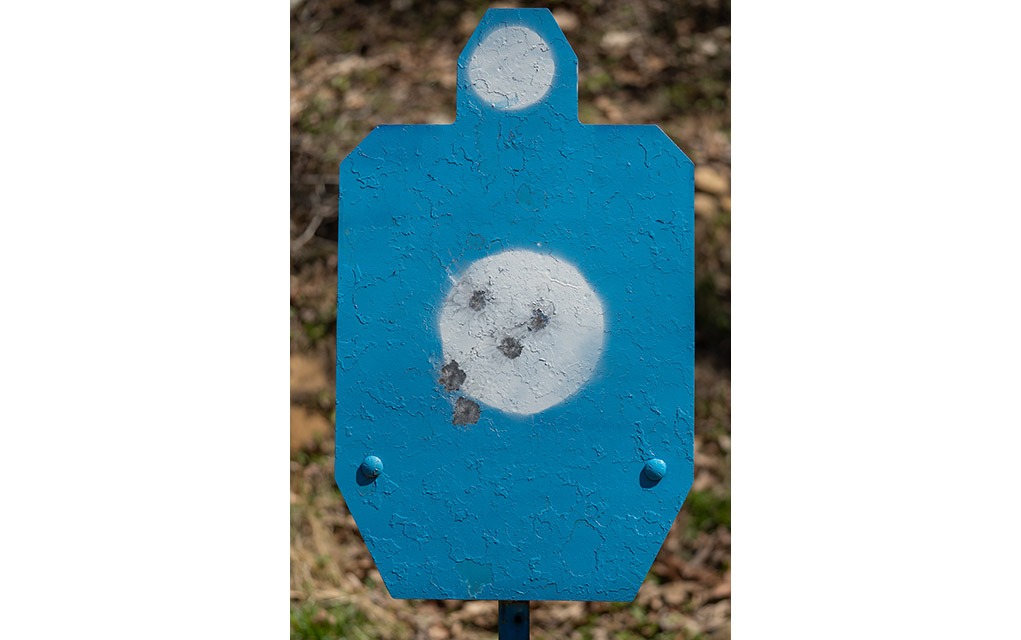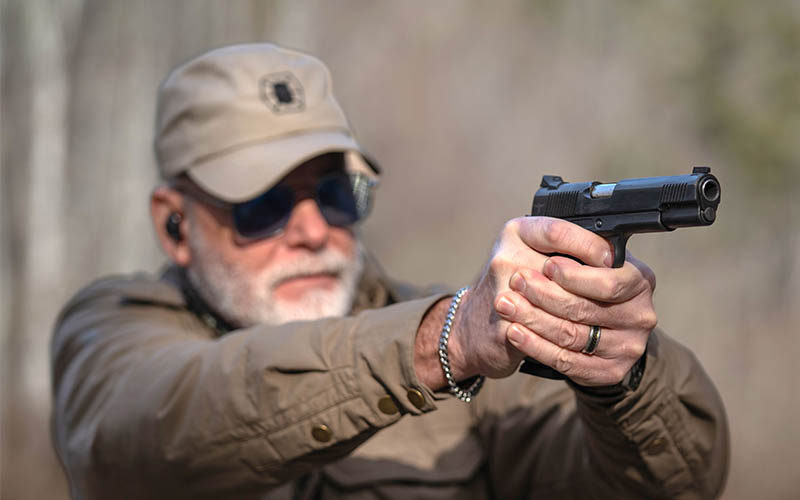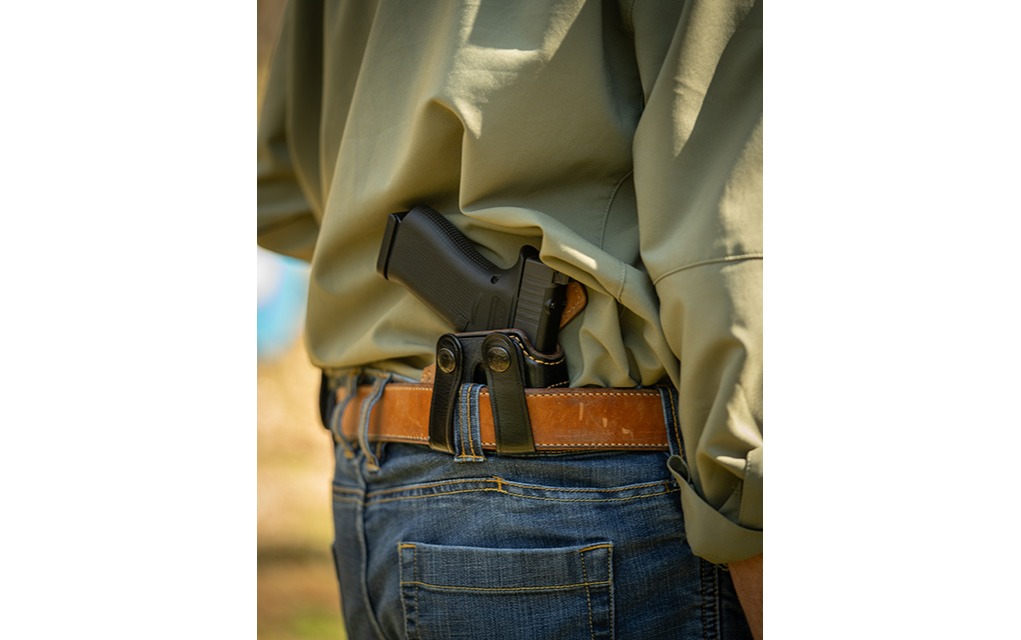
When it comes to guns, everything is a tradeoff. With defensive handguns, that means balancing accuracy, power and speed.
The USPSA (United States Practical Shooting Association) represents more than 37,000 members and more than 400 affiliated clubs. It’s the largest practical shooting association in the United States, and it’s the second largest region within IPSC (International Practical Shooting Confederation), which was founded in part by Jeff Copper.
Collectively, IPSC and USPSA have provided a test bed for equipment and techniques, some of which are now standard for police and military training. There are three letters displayed on the USPSA logo—DVC—and they represent the foundational guide for both organizations.
DVC are initials for the Latin words, Diligentia, Vis, Celeritas, which mean accuracy, power and speed. The acronym was popularized by former Marine, firearms trainer and gun writer, Jeff Cooper, who also founded the American Pistol Institute, now known as Gunsite Academy. Maybe to the annoyance of some, I routinely reference Cooper in this column. But, like Robbie Barrkman, who was the first gunsmith at Gunsite and founder of Robar, I believe we can link everything related to the defensive handgun today to the work and philosophy of Cooper. Yes, there have been advancements, but Cooper laid the foundation.
As established by Cooper, DVC is a triangular approach to the application of the defensive handgun. It’s a triangle that every shooter must balance so that they can deliver a sufficient level of power, accurately and as fast as possible. In an article written by Jeremy D. Clough, he compares DVC to a quote from Confederate General Nathan Bedford Forrest who famously said, “Get there the firstest with the mostest.”
This is a great analogy and good advice, but DVC, as it relates to the use of a defensive handgun, will be different for everyone. What’s often overlooked is that you must balance DVC to best suit you.
Diligentia = Accuracy

Of the three elements of DVC, the concept of accuracy is the least negotiable. As it relates to the defensive handgun, it varies from a hit in the lethal area of the target to a hit center mass of the available target. If you must shoot to save your life, bullets placed at the center of the lethal area will most often provide the fastest relief. Short of that, any hit is better than no hit, and a hit located center mass of the available target is the easiest to obtain.
Vis = Power


Cooper felt appropriate defensive handgun power started with the .45 Auto. However, not all shooters are capable of wielding a pistol chambered in .45 Auto efficiently and effectively. For some, the handgun is too big; for others, it recoils too much—and with today’s miniature pistols that are so popular, many can find it impossible to control. This is why the 9mm Luger is so popular: Most shooters can manage it well, either in a duty or ultra-compact pistols.
The point of this element of the DVC triangle is that you need enough power to get the job done. To incorporate these cartridge/power differences, IPSC applies points to hits based on a power factor rating of the cartridge being fired. You are left with logic when it comes to the power decision.
Celeritas = Speed


This doesn’t apply to the speed of the bullet, but to the speed with which you can obtain your hits. It is highly dependent on shooter skill as well as the shooter’s ability to effectively control the power level of the handgun—for subsequent shots/hits—in the size handgun they have chosen to use.
Finding Your Balance
There’s no shortage of self-defense shooting drills for measuring your abilities and skill. I’ve championed several in these pages, such as the Forty-Five Drill and the Step Back Drill. These and others are a measure of accuracy (diligentia) and speed (celeritas). If you can shoot them to standard, you can assume a reasonable level of proficiency.
The unmeasured element here is power (vis). All these drills are easier to shot with a .22 rimfire pistol than they are with a .357 Magnum. You must balance your DVC triangle with the most powerful handgun you can use to obtain good hits—quickly. Since we cannot sacrifice accuracy, it mostly becomes a balance of speed and power.
For example, I’ve found that I can shoot a 5-inch 1911 about 8 percent faster than I can shoot a 4-inch 1911, and about 19 percent faster than I can shoot a 3-inch 1911. Similarly, I can shoot a 4-inch 1911 in 9mm about 14 percent faster than I can shoot a 4-inch 1911 in .45 Auto, but the 9mm does not hit as hard.
The .357 Magnum has a great reputation as a stopper of bad men and gives an edge to the power side of the DVC triangle. But its increased recoil negatively impacts the speed side. For me, I’m about 8 percent slower with a .357 than I am with a .45 Auto. Is that extra power worth the reduction in speed with which I can fire accurate follow-up shots? In my opinion it’s not, and this illustrates the DVC decisions we must all make.
DVC vs. EDC


Shooting drills are a great tool to help us make these comparisons and decisions, but DVC cannot measure concealability and carry comfort. No matter how well you shoot whatever gun you might have, if you cannot carry it concealed and comfortably, you probably won’t, and that’s when your insurance policy becomes more important than DVC.
The DVC versus EDC (everyday carry) is another balance that must be found. Like with balancing DVC, the DVC/EDC balance will vary for everyone. Seek guidance, conduct experiments and make your own choices based on your findings. After all, it’s your life that will hang in the balance you find.
Editor’s Note: This article originally appeared in the July 2024 issue of Gun Digest the Magazine.
More On Defensive Handgunnery:


Next Step: Get your FREE Printable Target Pack
Enhance your shooting precision with our 62 MOA Targets, perfect for rifles and handguns. Crafted in collaboration with Storm Tactical for accuracy and versatility.
Subscribe to the Gun Digest email newsletter and get your downloadable target pack sent straight to your inbox. Stay updated with the latest firearms info in the industry.
Read the full article here

